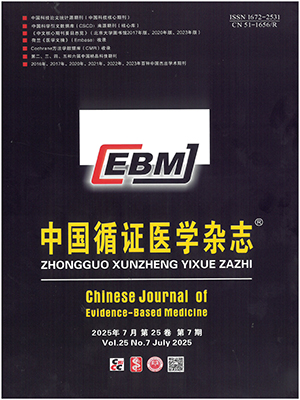| 1. |
Chowdhury MZI, Turin TC. Variable selection strategies and its importance in clinical prediction modelling. Fam Med Community Health, 2020, 8(1): e000262.
|
| 2. |
聂朦, 邬娜, 袁志权, 等. 临床流行病学研究中多因素分析时的变量选择方法. 中华内科杂志, 2024, 63(5): 462-467.
|
| 3. |
Xie J, Lin Y, Yan X, et al. Category-adaptive variable screening for ultra-high dimensional heterogeneous categorical data. J Am Stat Assoc, 2020, 115(530): 747-760.
|
| 4. |
Tennant PWG, Murray EJ, Arnold KF, et al. Use of directed acyclic graphs (DAGs) to identify confounders in applied health research: review and recommendations. Int J Epidemiol, 2021, 50(2): 620-632.
|
| 5. |
Digitale JC, Martin JN, Glymour MM. Tutorial on directed acyclic graphs. J Clin Epidemiol, 2022, 142: 264-267.
|
| 6. |
Dekkers OM, Laugesen K, Groenwold RHH. Directed acyclic graphs in clinical research. Eur J Endocrinol, 2024, 190(4): E5-E7.
|
| 7. |
Staerk C, Byrd A, Mayr A. Recent methodological trends in epidemiology: no need for data-driven variable selection. Am J Epidemiol, 2024, 193(2): 370-376.
|
| 8. |
Talbot D, Massamba VK. A descriptive review of variable selection methods in four epidemiologic journals: there is still room for improvement. Eur J Epidemiol, 2019, 34(8): 725-730.
|
| 9. |
Corazza GR, Formagnana P, Lenti MV. Bringing complexity into clinical practice: an internistic approach. Eur J Intern Med, 2019, 61: 9-14.
|
| 10. |
Grätz M. When less conditioning provides better estimates: overcontrol and endogenous selection biases in research on intergenerational mobility. Qual Quant, 2022, 56(5): 3769-3793.
|
| 11. |
Feeney T, Hartwig FP, Davies NM. How to use directed acyclic graphs: guide for clinical researchers. BMJ, 2025, 388: e078226.
|
| 12. |
Suzuki E, Shinozaki T, Yamamoto E. Causal diagrams: pitfalls and tips. J Epidemiol, 2020, 30(4): 153-162.
|
| 13. |
Westreich D, Greenland S. The table 2 fallacy: presenting and interpreting confounder and modifier coefficients. Am J Epidemiol, 2013, 177(4): 292-298.
|
| 14. |
Byeon S, Lee W. Directed acyclic graphs for clinical research: a tutorial. J Minim Invasive Surg, 2023, 26(3): 97-107.
|
| 15. |
Matsouaka RA, Liu Y, Zhou Y. Variance estimation for the average treatment effects on the treated and on the controls. Stat Methods Med Res, 2023, 32(2): 389-403.
|
| 16. |
Ferguson KD, Mccann M, Katikireddi SV, et al. Evidence synthesis for constructing directed acyclic graphs (ESC-DAGs): a novel and systematic method for building directed acyclic graphs. Inter J Epidemiol, 2020, 49(1): 322-329.
|
| 17. |
郝允逸, 夏雪, 胥芹, 等. 有向无环图的构建规范: ESC-DAGs方法介绍及脑血管病研究案例解读. 中国卒中杂志, 2024, 19(10): 1221-1229.
|
| 18. |
Hasani WSR, Musa KI, Chen XW, et al. Constructing causal pathways for premature cardiovascular disease mortality using directed acyclic graphs with integrating evidence synthesis and expert knowledge. Sci Rep, 2024, 14(1): 28849.
|
| 19. |
Rodrigues D, Kreif N, Lawrence-Jones A, et al. Reflection on modern methods: constructing directed acyclic graphs (DAGs) with domain experts for health services research. Int J Epidemiol, 2022, 51(4): 1339-1348.
|
| 20. |
Xu J, Wang Y, He Q, et al. Evaluating the agreement between sensitivity and primary analyses in observational studies using routinely collected healthcare data: a meta-epidemiology study. BMC Med, 2025, 23(1): 393.
|
| 21. |
Inoue K, Sakamaki K, Komukai S, et al. Methodological tutorial series for epidemiological studies: confounder selection and sensitivity analyses to unmeasured confounding from epidemiological and statistical perspectives. J Epidemiol, 2025, 35(1): 3-10.
|
| 22. |
Vanderweele TJ, Ding P. Sensitivity analysis in observational research: introducing the e-value. Ann Inter Med, 2017, 167(4): 268-274.
|
| 23. |
Faries D, Gao C, Zhang X, et al. Real effect or bias? Best practices for evaluating the robustness of real-world evidence through quantitative sensitivity analysis for unmeasured confounding. arXiv, 2023.
|
| 24. |
盛松, 郭曼萍, 赵阳, 等. 效应改变法和有向无环图在线性回归变量筛选中的应用及实现. 中国循证心血管医学杂志, 2024, 16(10): 1175-1178.
|
| 25. |
Lee PH, Burstyn I. Identification of confounder in epidemiologic data contaminated by measurement error in covariates. BMC Med Res Methodol, 2016, 16: 54.
|
| 26. |
Parida PK, Marwala T, Chakraverty S. A multivariate additive noise model for complete causal discovery. Neural Netw, 2018, 103: 44-54.
|
| 27. |
Viinikka J, Hyttinen A, Pensar J, et al. Towards scalable Bayesian learning of causal DAGs. arXiv, 2020.
|
| 28. |
Piccininni M, Konigorski S, Rohmann JL, et al. Directed acyclic graphs and causal thinking in clinical risk prediction modeling. BMC Med Res Methodol, 2020, 20(1): 1-12.
|
| 29. |
Zhu S, Ng I, Chen Z. Causal discovery with reinforcement learning. arXiv, 2020.
|
| 30. |
Sirazitdinov A, Buchwald M, Heuveline V, et al. Graph neural networks for individual treatment effect estimation. IEEE Access, 2024, 12: 106884-106894.
|




